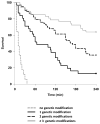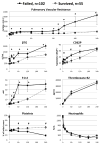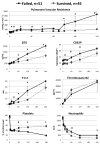Meta-analysis of the independent and cumulative effects of multiple genetic modifications on pig lung xenograft performance during ex vivo perfusion with human blood
- PMID: 25470239
- PMCID: PMC4390422
- DOI: 10.1111/xen.12149
Meta-analysis of the independent and cumulative effects of multiple genetic modifications on pig lung xenograft performance during ex vivo perfusion with human blood
Abstract
Background: Genetically modified pigs are a promising potential source of lung xenografts. Ex vivo xenoperfusion is an effective platform for testing the effect of new modifications, but typical experiments are limited by testing of a single genetic intervention and small sample sizes. The purpose of this study was to analyze the individual and aggregate effects of donor genetic modifications on porcine lung xenograft survival and injury in an extensive pig lung xenoperfusion series.
Methods: Data from 157 porcine lung xenoperfusion experiments using otherwise unmodified heparinized human blood were aggregated as either continuous or dichotomous variables. Lungs were wild type in 17 perfusions (11% of the study group), while 31 lungs (20% of the study group) had one genetic modification, 40 lungs (39%) had 2, and 47 lungs (30%) had 3 or more modifications. The primary endpoint was functional lung survival to 4 h of perfusion. Secondary analyses evaluated previously identified markers associated with known lung xenograft injury mechanisms. In addition to comparison among all xenografts grouped by survival status, a subgroup analysis was performed of lungs incorporating the GalTKO.hCD46 genotype.
Results: Each increase in the number of genetic modifications was associated with additional prolongation of lung xenograft survival. Lungs that exhibited survival to 4 h generally had reduced platelet activation and thrombin generation. GalTKO and the expression of hCD46, HO-1, hCD55, or hEPCR were associated with improved survival. hTBM, HLA-E, and hCD39 were associated with no significant effect on the primary outcome.
Conclusion: This meta-analysis of an extensive lung xenotransplantation series demonstrates that increasing the number of genetic modifications targeting known xenogeneic lung injury mechanisms is associated with incremental improvements in lung survival. While more detailed mechanistic studies are needed to explore the relationship between gene expression and pathway-specific injury and explore why some genes apparently exhibit neutral (hTBM, HLA-E) or inconclusive (CD39) effects, GalTKO, hCD46, HO-1, hCD55, and hEPCR modifications were associated with significant lung xenograft protection. This analysis supports the hypothesis that multiple genetic modifications targeting different known mechanisms of xenograft injury will be required to optimize lung xenograft survival.
Keywords: ex vivo lung perfusion; genetically engineered pig; immune response; lung xenotransplantation; thromboregulation.
© 2014 John Wiley & Sons A/S. Published by John Wiley & Sons Ltd.
Figures




Comment in
-
Commentary on "Meta-analysis of the independent and cumulative effects of multiple genetic modifications on pig lung xenograft performance during ex vivo perfusion with human blood" (by Harris et al.): tailoring donor pigs for xenotransplantation-how to find the right combination of genetic modifications?Xenotransplantation. 2015 Mar-Apr;22(2):112-3. doi: 10.1111/xen.12159. Epub 2015 Feb 25. Xenotransplantation. 2015. PMID: 25711248 No abstract available.
Similar articles
-
Lung xenotransplantation: a review.Curr Opin Organ Transplant. 2016 Jun;21(3):272-8. doi: 10.1097/MOT.0000000000000311. Curr Opin Organ Transplant. 2016. PMID: 26967998 Free PMC article. Review.
-
Transgenic expression of human leukocyte antigen-E attenuates GalKO.hCD46 porcine lung xenograft injury.Xenotransplantation. 2017 Mar;24(2). doi: 10.1111/xen.12294. Epub 2017 Mar 3. Xenotransplantation. 2017. PMID: 28258595
-
Commentary on "Meta-analysis of the independent and cumulative effects of multiple genetic modifications on pig lung xenograft performance during ex vivo perfusion with human blood" (by Harris et al.): tailoring donor pigs for xenotransplantation-how to find the right combination of genetic modifications?Xenotransplantation. 2015 Mar-Apr;22(2):112-3. doi: 10.1111/xen.12159. Epub 2015 Feb 25. Xenotransplantation. 2015. PMID: 25711248 No abstract available.
-
Synthetic liver function is detectable in transgenic porcine livers perfused with human blood.Xenotransplantation. 2018 Jan;25(1):10.1111/xen.12361. doi: 10.1111/xen.12361. Epub 2017 Oct 25. Xenotransplantation. 2018. PMID: 29067741 Free PMC article.
-
Progress and challenges in lung xenotransplantation: an update.Curr Opin Organ Transplant. 2018 Dec;23(6):621-627. doi: 10.1097/MOT.0000000000000582. Curr Opin Organ Transplant. 2018. PMID: 30234737 Review.
Cited by
-
Thromboxane and histamine mediate PVR elevation during xenogeneic pig lung perfusion with human blood.Xenotransplantation. 2019 Mar;26(2):e12458. doi: 10.1111/xen.12458. Epub 2018 Sep 3. Xenotransplantation. 2019. PMID: 30175863 Free PMC article.
-
The complex functioning of the complement system in xenotransplantation.Xenotransplantation. 2019 Jul;26(4):e12517. doi: 10.1111/xen.12517. Epub 2019 Apr 29. Xenotransplantation. 2019. PMID: 31033064 Free PMC article. Review.
-
Lung xenotransplantation: a review.Curr Opin Organ Transplant. 2016 Jun;21(3):272-8. doi: 10.1097/MOT.0000000000000311. Curr Opin Organ Transplant. 2016. PMID: 26967998 Free PMC article. Review.
-
Progress Toward Cardiac Xenotransplantation.Circulation. 2020 Oct 6;142(14):1389-1398. doi: 10.1161/CIRCULATIONAHA.120.048186. Epub 2020 Oct 5. Circulation. 2020. PMID: 33017208 Free PMC article. Review.
-
Xenotransplantation: Current Status in Preclinical Research.Front Immunol. 2020 Jan 23;10:3060. doi: 10.3389/fimmu.2019.03060. eCollection 2019. Front Immunol. 2020. PMID: 32038617 Free PMC article. Review.
References
-
- COOPER D, KEOGH A, BRINK J, et al. Report of the xenotransplantation advisory committee of the International Society for Heart and Lung Transplantation: the present status of xenotransplantation and its potential role in the treatment of end-stage cardiac and pulmonary diseases. J Heart Lung Transplant. 2000;19:1125–1165. - PubMed
-
- EKSER B, EZZELARAB M, HARA H, et al. Clinical xenotransplantation: the next medical revolution? Lancet. 2012;379:672–683. - PubMed
-
- COZZI E, VIAL C, OSTLIE D, et al. Maintenance triple immunosuppression with cyclosporin A, mycophenolate sodium and steroids allows prolonged survival of primate recipients of hDAF porcine renal xenografts. Xenotransplantation. 2003;10:300–310. - PubMed
-
- YAMADA K, YAZAWA K, SHIMIZU A, et al. Marked prolongation of porcine renal xenograft survival in baboons through the use of α1, 3-galactosyltransferase gene-knockout donors and the cotransplantation of vascularized thymic tissue. Nat Med. 2004;11:32–34. - PubMed
Publication types
MeSH terms
Substances
Grants and funding
LinkOut - more resources
Full Text Sources
Other Literature Sources
Medical
Research Materials
Miscellaneous

